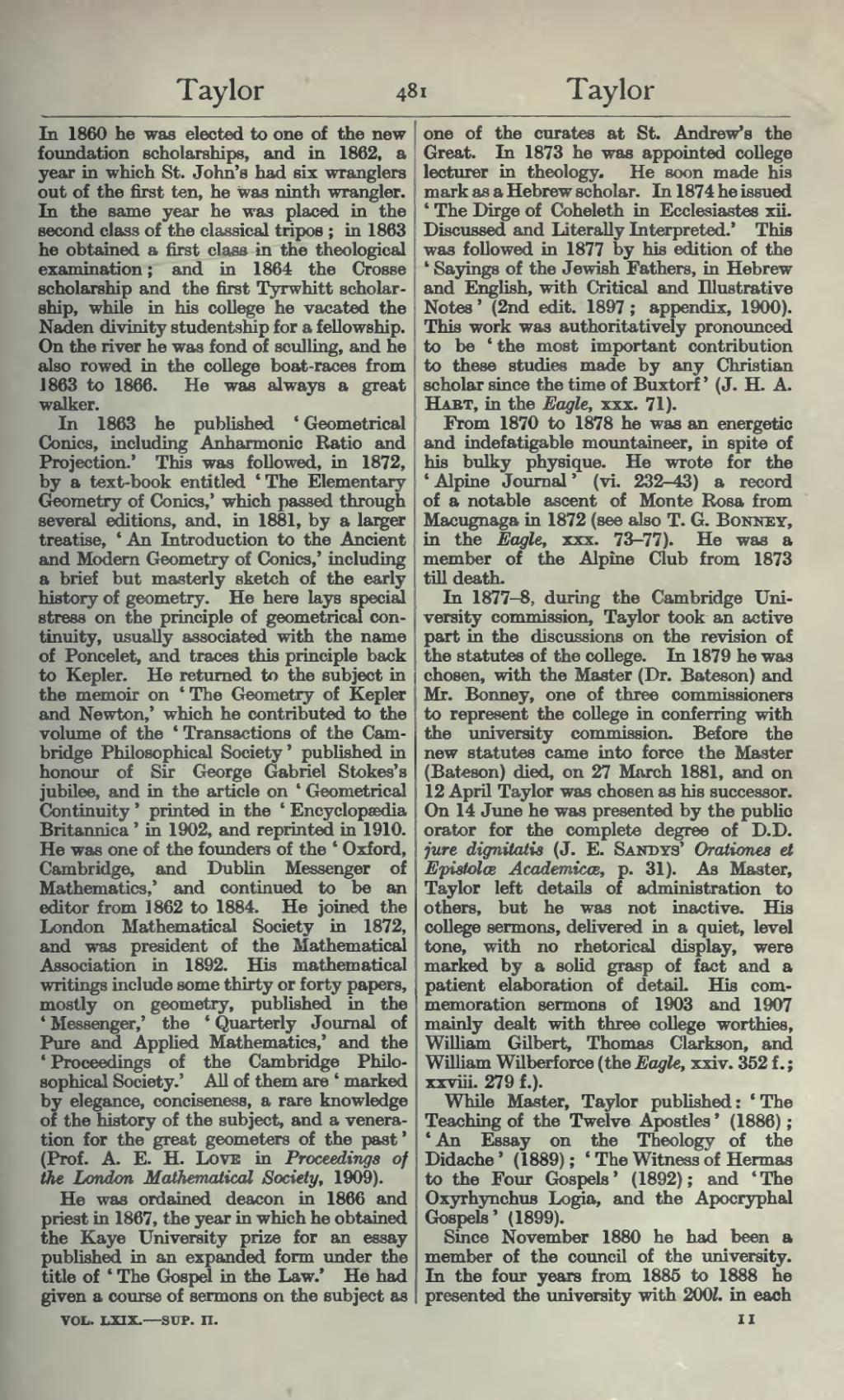In 1860 he was elected to one of the new foundation scholarships, and in 1862, a year in which St. John's had six wranglers out of the first ten, he was ninth wrangler. In the same year he was placed in the second class of the classical tripos; in 1863 he obtained a first class in the theological examination; and in 1864 the Crosse scholarship and the first Tyrwhitt scholarship, while in his college he vacated the Naden divinity studentship for a fellowship. On the river he was fond of sculling, and he also rowed in the college boat-races from 1863 to 1866. He was always a great walker.
In 1863 he published 'Geometrical Conics, including Anharmonic Ratio and Projection.' This was followed, in 1872, by a text-book entitled 'The Elementary Geometry of Conics,' which passed through several editions, and, in 1881, by a larger treatise, 'An Introduction to the Ancient and Modern Geometry of Conics,' including a brief but masterly sketch of the early history of geometry. He here lays special stress on the principle of geometrical continuity, usually associated with the name of Poncelet, and traces this principle back to Kepler. He returned to the subject in the memoir on 'The Geometry of Kepler and Newton,' which he contributed to the volume of the 'Transactions of the Cambridge Philosophical Society' published in honour of Sir George Gabriel Stokes's jubilee, and in the article on 'Geometrical Continuity' printed in the 'Encyclopædia Britannica' in 1902, and reprinted in 1910. He was one of the founders of the ' Oxford, Cambridge, and Dublin Messenger of Mathematics,' and continued to be an editor from 1862 to 1884. He joined the London Mathematical Society in 1872, and was president of the Mathematical Association in 1892. His mathematical writings include some thirty or forty papers, mostly on geometry, published in the 'Messenger,' the 'Quarterly Journal of Pure and Applied Mathematics,' and the 'Proceedings of the Cambridge Philosophical Society.' All of them are 'marked by elegance, conciseness, a rare knowledge of the history of the subject, and a veneration for the great geometers of the past' (Prof. A. E. H. Love in Proceedings of the London Mathematical Society, 1909).
He was ordained deacon in 1866 and priest in 1867, the year in which he obtained the Kaye University prize for an essay published in an expanded form under the title of 'The Gospel in the Law.' He had given a course of sermons on the subject as one of the curates at St. Andrew's the Great. In 1873 he was appointed college lecturer in theology. He soon made his mark as a Hebrew scholar. In 1874 he issued 'The Dirge of Coheleth in Ecclesiastes xii. Discussed and Literally Interpreted.' This was followed in 1877 by his edition of the 'Sayings of the Jewish Fathers, in Hebrew and English, with Critical and Illustrative Notes' (2nd edit. 1897 ; appendix, 1900). This work was authoritatively pronounced to be 'the most important contribution to these studies made by any Christian scholar since the time of Buxtorf' (J. H. A. Hart, in the Eagle, xxx. 71).
From 1870 to 1878 he was an energetic and indefatigable mountaineer, in spite of his bulky physique. He wrote for the 'Alpine Journal' (vi. 232–43) a record of a notable ascent of Monte Rosa from Macugnaga in 1872 (see also T. G. Bonney, in the Eagle, xxx. 73–77). He was a member of the Alpine Club from 1873 till death.
In 1877–8, during the Cambridge University commission, Taylor took an active part in the discussions on the revision of the statutes of the college. In 1879 he was chosen, with the Master (Dr. Bateson) and Mr. Bonney, one of three commissioners to represent the college in conferring with the university commission. Before the new statutes came into force the Master (Bateson) died, on 27 March 1881, and on 12 April Taylor was chosen as his successor. On 14 June he was presented by the public orator for the complete degree of D.D. jure dignitatis (J. E. Sandys' Orationes et Epistolæ Academicæ, p. 31). As Master, Taylor left details of administration to others, but he was not inactive. His college sermons, delivered in a quiet, level tone, with no rhetorical display, were marked by a solid grasp of fact and a patient elaboration of detail. His commemoration sermons of 1903 and 1907 mainly dealt with three college worthies, William Gilbert, Thomas Clarkson, and William Wilberforce (the Eagle, xxiv. 352 f.; xxviii. 279 f.).
While Master, Taylor published: 'The Teaching of the Twelve Apostles' (1886); 'An Essay on the Theology of the Didache' (1889); 'The Witness of Hennas to the Four Gospels' (1892); and 'The Oxyrhynchus Logia, and the Apocryphal Gospels' (1899).
Since November 1880 he had been a member of the council of the university. In the four years from 1885 to 1888 he presented the university with 200l. in each
